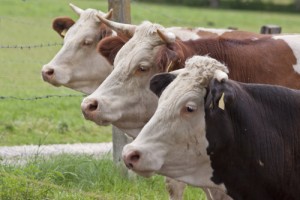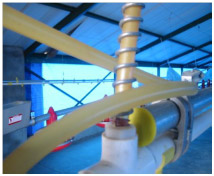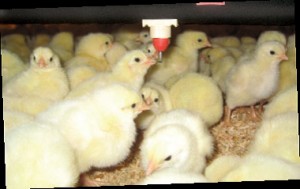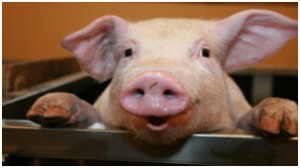Food security and the production thereof can be very dynamic. The work begins at the primary sector and goes down the commercial chain of processing and packaging all the way to the consumer at the end. Dr. Gilbert Hinze has worked with ECA through the process and describes the application of ECA in the food production sector as versatile, where it can be applied from the farm to the fork.
Agriculture cannot operate without water and in many cases the water is collected on site via boreholes, dams, rivers, oceans or other applicable water sources. Both animals and plants drink the water in large volumes, therefore, it is critical that a biosecurity solution is made available to farmers to manage their water, agricultural growing and animal rearing practices effectively and efficiently without using harmful chemicals and antibiotics.
DAIRY FARMING
 Animal farmers are constantly looking for ways to improve performance. Experience has shown that application of ECA products produce the following benefits:
Animal farmers are constantly looking for ways to improve performance. Experience has shown that application of ECA products produce the following benefits:
- Improvement in food conversion ratio
- Reduced factory downtimes
- Healthy and more active animals resulting in lower mortality rates
- Creation of a regime which allows for the elimination of routine bacteria in feed
- Weight gain in animals
- Mortality rate reduction
- Medicine cost reduction by
- Increase in milk production
- More effective disease control and cure;
- Complete hygiene protocol without chemicals.
Applications for Eco-Lyte solutions:
Anolyte
- Teat dip sterilisation
- Drinking water treatment: Anolyte is safe and non-toxic, even at full strength.
- Hoof bath: Treat hoof infections, use undiluted Anolyte at least once daily for 7-10 days.
- Skin and wound treatment: Apply undiluted Anolyte to any superficial skin infection and wound care.
- Neonatal diarrhoea treatment
- Mastitis treatment, uterus and udder disinfection
- Metritis prevention
- Milk line disinfection
- Silage disinfection and preservation
- Barn and milking shed disinfection and cleaning. Runoff is sterile and can actually improve water quality.
Catholyte:
Milk line cleaner – Catholyte effectively removes protein/fat deposits, followed by Anolyte for disinfection (heating the Catholyte to 40°C beforehand improves washing performance)
Cleaning of clothing, overalls, etc. – works very well as a general detergent
POULTRY FARMING (Broilers, Growers and Layers)
 ECA products used as an application in the poultry industry is fast becoming the most successful of all applications. Due to the years and years of R&D and clinical studies conducted by Dr Gilbert Hinze IQ ECA Technologies has managed to develop a blue print solution that can be slightly adapted to each poultry client providing the following key benefits:
ECA products used as an application in the poultry industry is fast becoming the most successful of all applications. Due to the years and years of R&D and clinical studies conducted by Dr Gilbert Hinze IQ ECA Technologies has managed to develop a blue print solution that can be slightly adapted to each poultry client providing the following key benefits:
Removal of biofilm from water drinking lines and wet walls
- In all the broilers houses where IQ ECA Solution is used no slime or biofilm is present, no blockages are recorded, bacterial counts are repeatedly zero, and all inline filters are consistently clean.
Dust and ammonia reduction:
- Up to 60% reduction of the ammonia content in the air is observed when compared to houses that are not fogged with IQ ECA Solution.
- We experience a settling of dust due to the electrostatic nature of the misting solution.
External infection control and general bio-security
- The residual IQ ECA Solution levels in the drinking water have the potential to eliminate exogenous pathogens ingested via litter pecking or contaminated food.
- By killing pathogens before they reach the gut of the animals ultimately assists in preventing infection.
- the potential to remove the application of antibiotics in animal rearing
It was postulated that the dosed IQ ECA Solution would kill bacterial pathogens in the drinking water as well as kill freshly ingested pathogens from pecking litter or ingestion of contaminated food. In other words, the use of IQ ECA Solution in broiler farming creates a bio-secure environment and can assist in the ‘pre-pyloric’ disinfection of the oral cavity, esophagus and would assist in preventing the development of infectious diseases.
 Our initial trials in the Broiler Industry is consistently showing improved performance figures in three key production areas, helping to improve a farms PEF performance and hence income stream:
Our initial trials in the Broiler Industry is consistently showing improved performance figures in three key production areas, helping to improve a farms PEF performance and hence income stream:
- Increased weights
- Decreased mortalities
- Decreased feed conversion rates
PIG REARING
The use of electrochemistry in infection control in the pig industry is not new. It has been practiced in Europe for many years and only now in Africa with the development of ECA devises can the same protocols be introduced.
 Infection control studies of the living environment for pigs indicate that adequate sanitation between and during life cycles still holds the major key to addressing the problems of recurring disease. Studies indicate that buildings can be prone to ‘handing on’ to disease due to a variety of sometimes unfathomable factors.
Infection control studies of the living environment for pigs indicate that adequate sanitation between and during life cycles still holds the major key to addressing the problems of recurring disease. Studies indicate that buildings can be prone to ‘handing on’ to disease due to a variety of sometimes unfathomable factors.
Factors such as hygiene, quality and price are pivotal to an industry which is highly competitive and regulated by food standard bodies.
Pig producers are constantly looking for ways to improve performance. Factors which govern this goal are outlined below.
- Improvement in food conversion ratio
- Reduced factory downgrades
- Healthy and more active pigs
- Lower mortality rates
- Creating a regime which allows for the elimination of routine antibiotic use. [In feeds] Which can be used as a marketing plus
- Better feed conversion rates
Envirolyte Industries International Ltd. has the capability of taking a holistic approach to infection control in the industry from farrowing to fattening pigs.
Hygiene protocol for complete cycle:
- Pre and after farrowing udder disinfecting with Anolyte. The procedure should be continued 5 – 7 days after farrowing.
- Additional sow feed disinfecting with Anolyte 5 – 7 days before and 5 – 7 days after farrowing.
- Piglets feed disinfecting at a measured ratio after they are switched to dry or liquid feed.
- Drinking water disinfecting with Anolyte at a measured ratio.
- In case of diarrhoea a mixture of water and Anolyte should be given to a diseased animal.
Hygiene protocol for farrowing cycle:
- Disinfecting on a fixed schedule of pig barns by fogging Anolyte. Fixed ratio per m3 should be observed.
- Disinfecting of drinking water by Anolyte at a fixed ratio.
- In case of acute diarrhoea a mixture at certain ratio of Anolyte and water should be given to piglets. Fogging of Anolyte on a more frequent schedule is advised.
- When doing castration Anolyte should be applied for fast recovery.
- Uterus disinfecting with Anolyte is also advised.
Hygiene protocol for a weaner cycle:
- Pig farm disinfecting by fogging Anolyte before new arrivals and during the cycle on a fixed schedule.
- Drinking water disinfecting by adding Anolyte into the water at a certain ratio.
- In case of acute diarrhoea use mixture of Anolyte and water as advised for Farrowing cycle.
Hygiene protocol for Grower / Finisher cycle:
- Drinking water disinfecting by adding Anolyte into the water at a certain ratio.
- Disinfecting of pig barns by fogging Anolyte at a certain ratio in the presence of animals and on a fixed schedule.
- Special fogging procedures should be applied in case of cough, pneumonia or any respiratory disease.
- For all cycles we advise to disinfect liquid and/or dry feed by spraying/adding Anolyte at a certain ratio per ton.